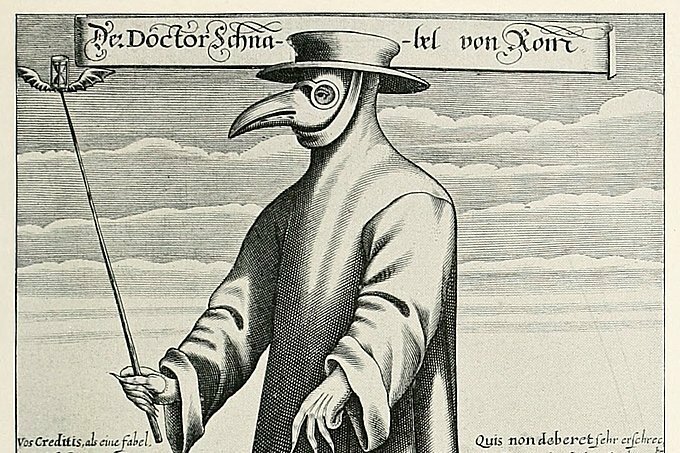THE black Plague or bubonic plague was a disease that devastated Asia and Europe in the century. XIV.
On the European continent, the epidemic lasted sixteen years, from 1347 to 1353, in the middle of the Middle Ages. An estimated 25 million people died, which meant a third of the population in Europe at that time.
The disease had its origins in Mongolia and spread to the West through the ships that carried out trade between Asia and Europe.
Summary of Black Death Origin
Reports of the Black Death were recorded during the war between Genoese and Mongols fought in the city of Caffa (present-day Theodosia), on the Crimean Peninsula, in 1346.
Seeing that the Muslim Mongols died, the Catholic Genoese attributed the disease to divine justice, as it was an unmistakable sign that God would be on the side of the Christians.
When the dispute ends, the Genoese return to the Italian Peninsula taking on board rats that harbored fleas and they were the ones who transmitted the disease's bacteria. Another way of propagation was the Silk Road, where caravans from the East traveled to European markets.
These rats will come into contact with their European counterparts and the disease is thus spread from ports such as Venice, Marseilles, Barcelona, Valencia, etc.
What are the symptoms of the Black Death?
Let's look at some of the symptoms of the black or bubonic plague:
- body aches
- High fever
- cough
- thirst
- bleeding from the nose and other orifices
- swelling in the nodes and appearance of bulbs
The symptoms of the Black Death were similar to those of a very bad flu, but with the important difference that the ganglia swelled. Then, bumps appeared on the skin that looked like the bulbs of plants. Because of this, the disease is also called "bubonic plague".
See too: Bubonic plague
Black Death Doctors
During the Black Death, cities hired doctors to treat the sick. These were not always qualified or had medical studies, but were accepted with the hope that they would bring a cure.

In the 17th century, doctors wore a mask made of leather and with a beak that resembled that of a bird. Inside it were aromatic herbs to prevent contagion, as for a long time it was believed that the disease was transmitted through the air. These herbs also helped to withstand the stink of putrefaction from the corpses.
These doctors made a lot of money during epidemic periods, but ironically not all of them survived the plague.
What was the cure for the Black Death?
To cure the Black Death, there wasn't much to do but isolate the sick. Even so, the contagion reached and killed the inhabitants of entire villages, emptied monasteries and frightened populations.
The authorities decreed the isolation of the affected regions - remember that in the Middle Ages several cities were walled and could be closed easily.
Another measure was to light fires and burn herbs so that the smoke would carry the disease away. Drinks made from valerian and vervain were also used in order to treat the sick.
How did the Black Death end?
The Black Death epidemic came to an end due to hygienic measures such as confinement, the construction of hospitals outside the city walls and the incineration of the dead. With that, the contagions decreased.
The truth, however, is that the Black Death was not extinct, as outbreaks of this disease were recorded all over the world until the beginning of the century. XX.
In fact, currently, about three thousand people die from this disease every year.
Consequences of the Black Death
While the Black Death ravaged Europe, France and England were fighting in the Hundred Years War. These two factors will provoke a series of social and economic changes in the Low Middle Ages.
With the lack of manpower, the servants thought that the wage for the working day would increase, but this almost did not happen. This fact generated several peasant revolts that destabilized medieval society.
In turn, most serfs leave the countryside and go to cities where there was more work and resources. Thus, the power of the bourgeoisie begins to grow, starting the crisis of feudalism and the bourgeois revolution.
Likewise, there were those who appropriated land, goods and inheritances that were left abandoned by those who had died victims of the plague.
Likewise, religious orders of flagellants who used to mutilate themselves to seek forgiveness of sins emerged. Indulgences, granted by the Catholic Church, also gained strength, as everyone tried to ensure a good death. Later, this attitude would be criticized by Matinho Luther, promoter of the Protestant Reformation.
Black Death in Brazil
Brazil suffered an epidemic of the Black Death from 1900 to 1907.
In 1899, the city of Porto, in Portugal, was attacked by this disease and probably the Brazilian ships that traded there brought the rat and its fleas.
Initially, cases were registered in Santos (SP), but it was the city of Rio de Janeiro, then capital of the country, that faced the greatest consequences. In addition, yellow fever, which was epidemic at the time, and smallpox joined the bubonic plague, making the situation chaotic.
These diseases were only extinguished through drastic measures of hygiene, vaccination and basic sanitation. However, these were applied without due clarification to the population and gave rise to the Vaccine Revolt, in 1904.
We have more texts related to the subject for you:
- low middle age
- Hundred Years War
- Fall of Constantinople
- Largest pandemics in human history
- Spanish flu

